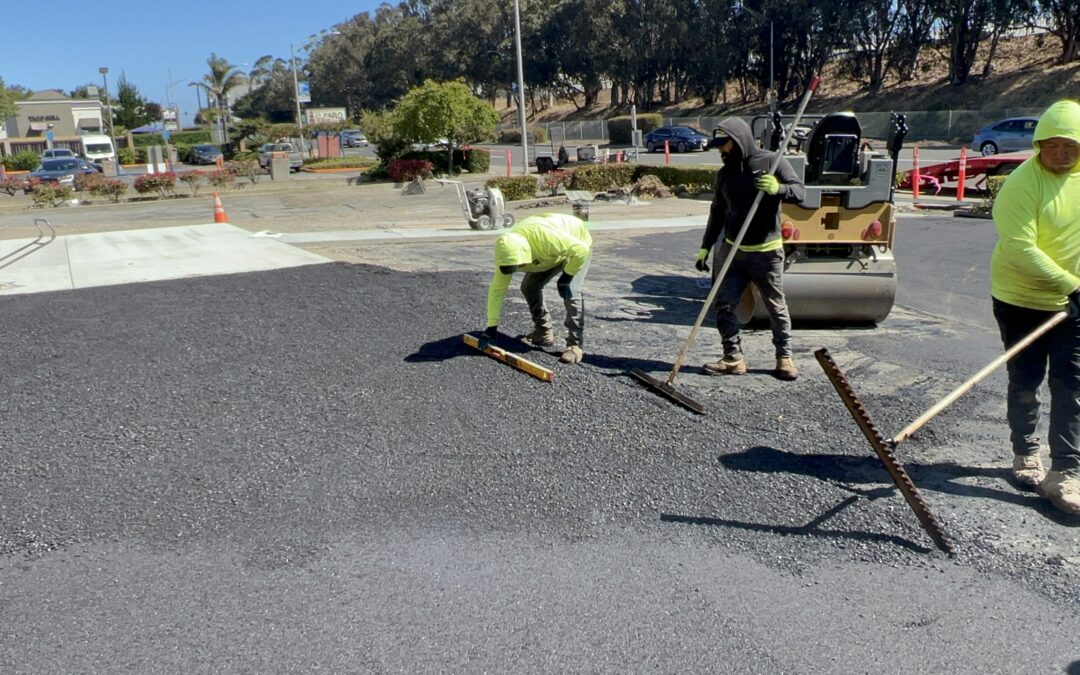Asphalt and concrete are two of the most common materials used for paving surfaces like driveways, parking lots, and roadways. Property owners in San Francisco, California, may wonder if it’s possible to pour asphalt over an existing concrete surface and what factors need to be considered. This blog post will delve into the feasibility, benefits, and potential challenges of overlaying asphalt on concrete, with a special focus on the unique conditions in San Francisco.
Feasibility of Pouring Asphalt Over Concrete
Pouring asphalt over an existing concrete surface is indeed possible and can be a cost-effective and efficient solution for many property owners. However, certain conditions and considerations must be met to ensure a successful and durable outcome.
1. Structural Integrity
The underlying concrete must be in good condition. If the concrete is significantly cracked, uneven, or unstable, these issues can transfer to the new asphalt layer, leading to premature failure. Inspecting and repairing any major defects in the concrete before overlaying with asphalt is crucial.
2. Proper Preparation
Proper surface preparation is key to a successful asphalt overlay. This includes cleaning the concrete surface, addressing any surface defects, and applying a tack coat to ensure proper adhesion between the concrete and the new asphalt layer.
3. Expansion Joints
Concrete surfaces typically have expansion joints to accommodate temperature-induced expansion and contraction. These joints can cause reflective cracking in the asphalt overlay if not properly managed. Installing a reinforcing grid or using a thicker asphalt layer can help mitigate this issue.
Benefits of Asphalt Over Concrete
Overlaying asphalt on concrete offers several benefits, particularly in a city like San Francisco, where climate and urban density present unique challenges.
1. Cost-Effectiveness
Pouring asphalt over existing concrete is generally more cost-effective than removing the old concrete and installing a new asphalt surface from scratch. This approach saves on labor, materials, and disposal costs.
2. Improved Aesthetics and Performance
Asphalt can provide a smoother and more uniform surface compared to aged and weathered concrete. It also offers better traction and can be easily resurfaced or repaired over time.
3. Faster Installation
Since the existing concrete serves as a stable base, the installation process for an asphalt overlay is typically quicker and less disruptive than a full reconstruction.
Challenges and Considerations in San Francisco
San Francisco’s unique climate and geographical features necessitate special considerations when overlaying asphalt on concrete.
1. Seismic Activity
San Francisco is located in an active seismic zone, which can impact the stability of both concrete and asphalt surfaces. Ensuring that the concrete base is structurally sound and reinforcing the asphalt overlay can help mitigate the risk of damage from seismic activity.
2. Temperature Fluctuations
While San Francisco enjoys a relatively mild climate, temperature fluctuations can still affect the performance of asphalt surfaces. Proper installation techniques and the use of high-quality materials can help ensure that the asphalt overlay withstands these conditions.
3. Drainage Considerations
Proper drainage is essential to prevent water from pooling on the surface and causing damage. The existing concrete surface should be assessed to ensure it has adequate drainage, and any necessary adjustments should be made before overlaying with asphalt.
Best Practices for Asphalt Overlays in San Francisco
To achieve the best results when pouring asphalt over concrete in San Francisco, consider the following best practices:
1. Thorough Inspection and Preparation
Conduct a thorough inspection of the existing concrete surface to identify any structural issues that need to be addressed. Properly clean and prepare the surface, and apply a tack coat to ensure good adhesion.
2. Use Quality Materials
Using high-quality asphalt and reinforcing materials can enhance the durability and longevity of the overlay. Consider using polymer-modified asphalt, which offers better performance and resistance to cracking.
3. Professional Installation
Hiring a professional paving contractor with experience in asphalt overlays and knowledge of local conditions can ensure a successful project. Professionals can provide the expertise and equipment needed to properly install the asphalt overlay and address any site-specific challenges.
4. Regular Maintenance
Even with a well-installed asphalt overlay, regular maintenance is essential to extend its lifespan. This includes periodic inspections, crack sealing, sealcoating, and addressing any drainage issues promptly.
Conclusion
Pouring asphalt over an existing concrete surface is a viable option for many property owners in San Francisco. While it offers numerous benefits, including cost savings and improved aesthetics, it also requires careful planning, proper preparation, and professional installation to ensure success. By understanding the unique challenges posed by San Francisco’s climate and geological conditions, property owners can make informed decisions and achieve a durable and long-lasting asphalt surface.

